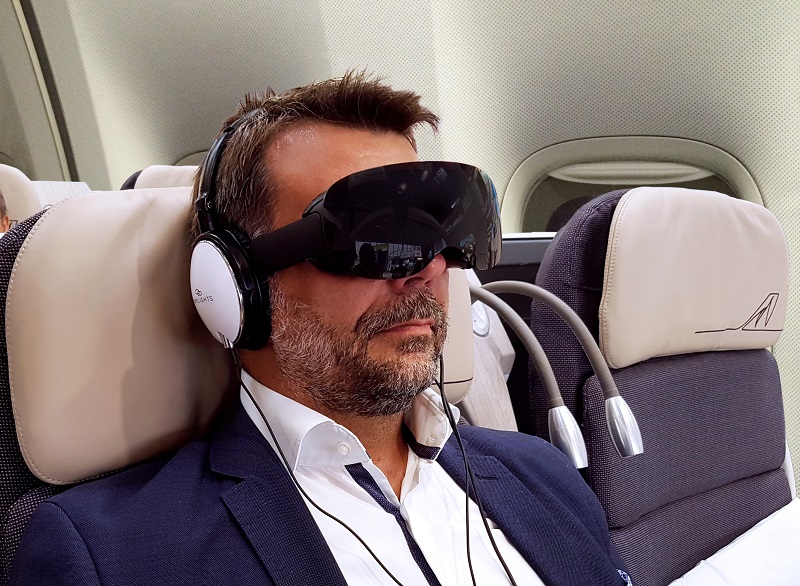For years now, there has been something of an open question about what precisely passengers get in terms of additional inflight entertainment when flying in first class, business or premium economy.
Indeed, even in the swankiest suites, it is rare to find an IFE monitor whose picture and content quality is better than an iTunes movie or downloaded Netflix an iPad. In first class, the screens are so far away that the effective screen size is smaller than a tablet on the tray table.
Enter virtual reality, which has been seen as something of a nifty bit of technology still lacking a killer app in the passenger experience world.
Using VR goggles as cinematic headsets, however, has proven increasingly popular, and the technology behind them has been evolving quickly.
READ: Backlash prompts airlines to cover seatback cameras.
No longer do you need to watch a blockbuster on a shiny, reflective screen in full daylight from open windows: just pop on the increasingly less stormtrooper-looking glasses and away you go into whichever movie you’re interested in.
Much as personal video on the aircraft began with handheld movie players in the pointy end of the plane, premium cabins will be home to much of the inflight VR revolution.
Garuda Indonesia’s latest partnership with Franco-American company Skylights, manufacturer of the AlloSky headset, is just one example of bringing the tech to business class on routes between Indonesia and Japan, a key and growing tourism market.
Crucially, one hurdle to their introduction has been the need to let cabin safety announcements penetrate the immersive entertainment system, and much work has been done with regulators to allow this to happen.
“In order to introduce the service on international flights, SkyLights and Garuda’s MRO subsidiary GMF AeroAsia worked in close collaboration to develop the new cabin announcement integration to meet the regulatory requirements set out by the DGCA (Indonesia’s safety regulator),” says Skylights.
“Compared to the wireless announcement solution supported by SkyLights’ AlloSky, the new system can be implemented immediately without integration into the cabin system or the need of a local network.”

“Implementing VR onboard works on a case by case basis,” explains Skylights chief executive David Dicko. “We are delighted to now be able to offer greater choice and flexibility when deploying our solution. Having it developed, validated and deployed in such a short period of time is a true testament to GMF AeroAsia and Garuda’s ability to innovate.”
“Through this safety integration,” Dicko notes, “our Allosky cinematic VR entertainment becomes even more accessible to airlines seeking to upgrade and differentiate their premium customer experience.”
But it’s not just providing it as a perk to premium class passengers: it’s also about offering the headsets for a fee throughout the aircraft, which Skylights has been trialing with a number of airlines including French leisure carrier Corsair. So, how do you maintain it as a premium experience in the pointy end?
Cue Stelia, the Airbus subsidiary seating manufacturer, which has worked with Skylights to enable a series of low-frequency speakers embedded in one of its Opal seats.
This technology is essentially a huge rumble strip that runs down your back and into the seat pan, and a demo at the recent Aircraft Interiors Expo clearly demonstrated the case beyond making blockbuster explosions really boom.
Indeed, the immersive experience of a musical-focussed cinematic experience like A Star Is Born was very impressive, but largely inaudible beyond the seat in the murmur of a relatively quiet corner of the show.
The trick will be persuading an airline that installing the rumble speakers in a seat makes sense. Could this be one of the benefits of a “front row better-than-business” product as advertised by Thompson and Collins, and as implemented by a couple of Chinese carriers?
























